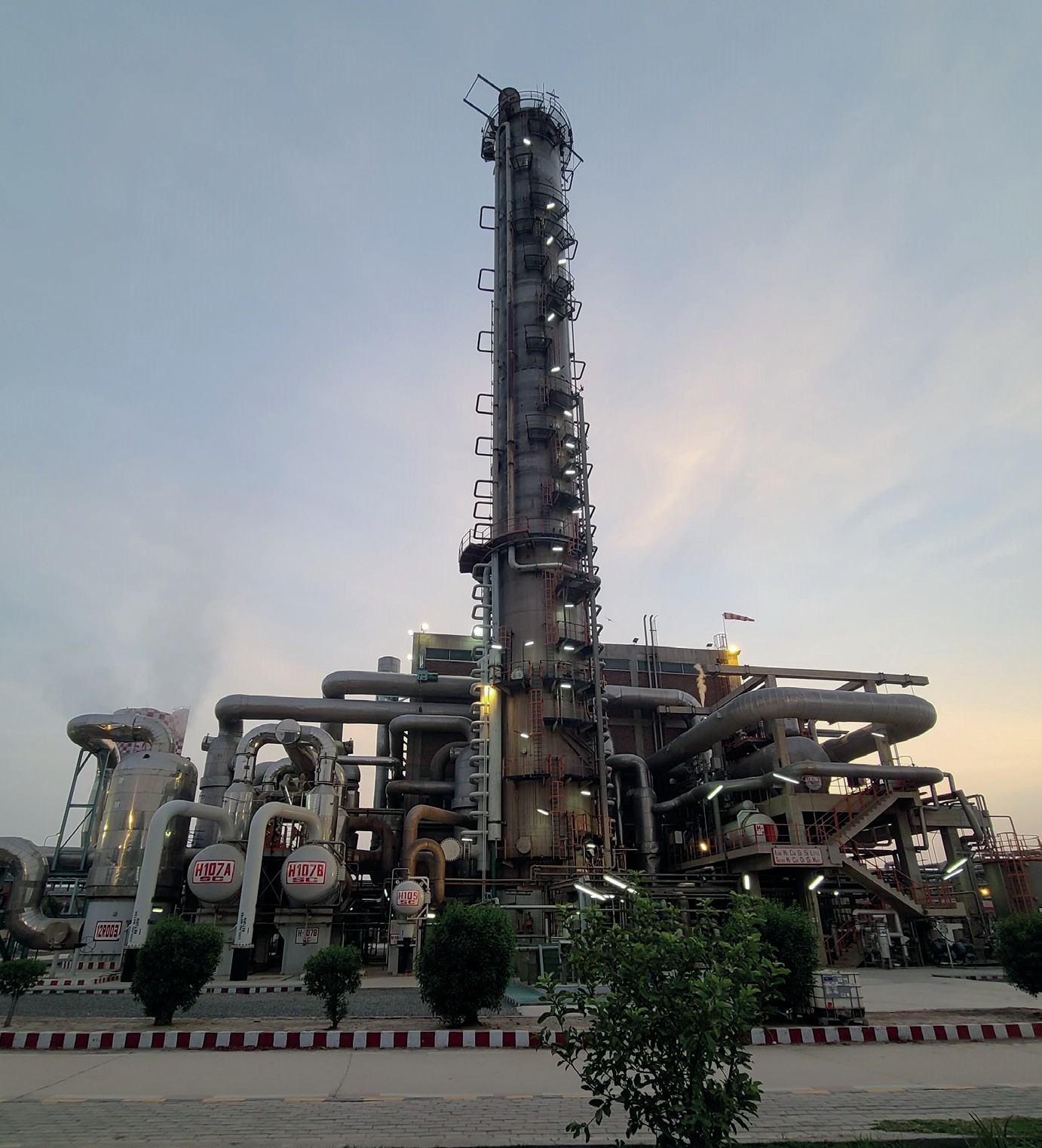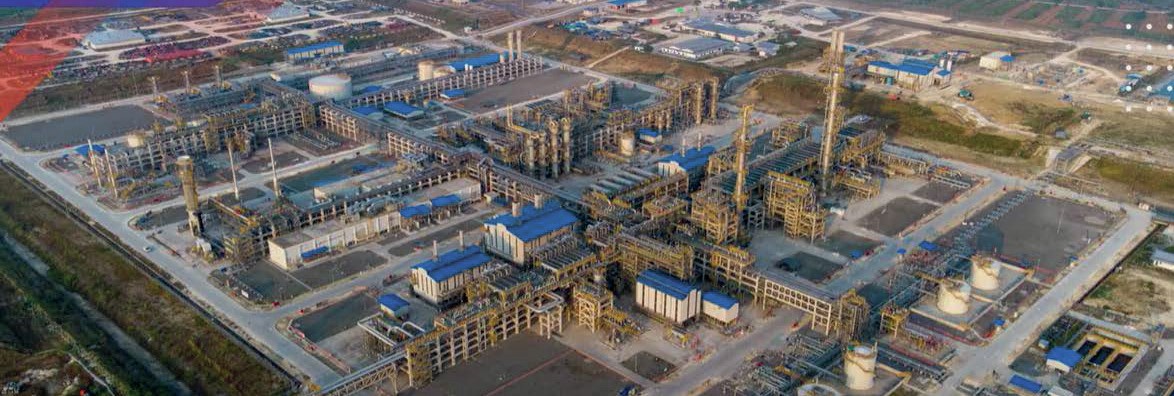Nitrogen+Syngas 391 Sep-Oct 2024

30 September 2024
Catalyst management and monitoring in nitric acid plants
NITRIC ACID
Catalyst management and monitoring in nitric acid plants
Based on 16 years of experience, Muhammad Nabeel Shakir of Fatima Fertilizer Company outlines a methodology to achieve optimum performance of the PGM catalyst and catchment system in nitric acid plants.

The PGM (Platinum Group Metals) ammonia oxidation catalyst along with the catchment system play a vital role in the manufacturing of nitric acid. Besides ammonia (feedstock), the PGM catalyst is the main consumable which drives the cost of nitric acid whether it is an intermediate or final product.
PGM catalyst usually consists of platinum and rhodium or platinum, rhodium and palladium depending upon the catalyst type meeting nitric acid manufacturer requirements, whereas the catchment system consists of palladium mainly. The catchment system is designed to recover the volatilised losses associated with ammonia oxidation. The ammonia oxidation process results in the loss of platinum as a gaseous oxide which then undergoes a transfer reaction on the catchment gauze. The catchment system is designed for recovery of volatilised platinum lost from the catalyst.
In view of risk associated with the damage of PGM catalyst during commissioning (mainly), start-up and normal operations of the nitric acid plant, keeping an expensive PGM catalyst in inventory as spare is always a challenge for nitric acid manufacturers.
The impact of nitric acid plant downtime and a long outage is significantly higher especially for large scale manufacturers producing fertilizers as the final product. For such large-scale manufacturing facilities, reliable and sustainable operation of the nitric acid plant is important to keep downstream units running.
Selection of PGM catalyst and catchment system
Specification of the PGM catalyst and catchment system depends on multiple variables and factors specific to the nitric acid manufacturer. All applicable data is usually exchanged and discussed among nitric acid and PGM catalyst manufacturers to finalise the most appropriate and best suited option. Key factors include campaign length, design parameters, operating philosophy of plant (commissioning phase, normal steady state operations, cyclic operations with frequent planned start-up and shutdowns, plant facing reliability issues with unplanned shutdowns, regulatory compliance requirements, metals recovery targets, etc.).
The campaign length – the design life of one complete catalyst and catchment system – is usually evaluated based on the ammonia oxidation reactor operating pressure, ammonia loading and catalyst replacement outage philosophy. Nitric acid plants with a low- to medium-pressure ammonia oxidation reactor are better suited to longer campaign lengths compared to high-pressure ammonia oxidation reactors due to the impact of pressure on mechanical strength and associated losses. Longer campaigns in general impact overall catalyst recovery, especially in case of contamination and excessive number of start-ups and shutdowns resulting in higher mechanical loss and hence higher net metal loss. Shorter campaigns involve catalyst replacement outage, fresh catalyst purchase cycle and spent catalyst refining process more than once per year depending upon the exact campaign duration. In such scenarios, ammonia to NO conversion efficiency and net metal losses are carefully analysed in comparison to additional catalyst replacement and refining expense due to shorter campaigns.
Operating philosophy and condition of plant is also crucial when selecting the PGM catalyst and catchment system as the probability of contamination (generally by iron) from the plant itself and through feedstock is higher for commissioning campaigns. In addition, frequent shutdowns and trips are also common during the plant commissioning phase which mechanically weakens the gauzes, resulting higher net metal loss.
A high number of starts and stops also favours the formation of rhodium oxide on the gauzes due to temperature cycling. The tendency for rhodium oxide formation increases with the amount of rhodium in the gauze. Rhodium oxide lowers the oxidation efficiency due to ammonia loss in unwanted side reactions. The rhodium content in the overall composition is evaluated based on strength requirement, operating zone (°C) of ammonia burner and rhodium oxide formation temperature (critical zone).
PGM catalyst gauze lightening (startup) procedure is also critically important, and trained operating teams ensure passing the rhodium oxide formation temperature rapidly as far as practically possible.
An evaluation of the optimum metal content and composition also covers the financial and regulatory impact associated with overall N2 O emissions from the nitric acid plant which is controlled through primary, secondary and tertiary abatement depending upon the system requirements and provision in design. Comparatively lower N2 O contents can be achieved through a customised PGM catalyst pack as primary abatement. Operating conditions also play a key role in the actual performance of the catalyst as the N2O content at the ammonia oxidation reactor varies with mixed gas temperature. The PGM catalyst should therefore by designed at mixed gas temperature after incorporating the effect of varying ambient conditions. Operating conditions and variables are modelled to evaluate the optimal metal content and expected levels of metal loss during the campaign. Permanent metal loss during the complete campaign should be considered carefully while evaluating the initial cost of a new catalyst pack and other benefits.
Another key consideration when evaluating the optimum cost-efficient solution, is less catalyst weight or fewer layers, which may result in ammonia slip downstream of the catalyst. In addition to productivity loss, i.e., lower ammonia to NO conversion efficiency, this ammonia slip also poses an explosion hazard in the downstream equipment by decomposition of ammonium nitrate. The presence of ammonium nitrate due to possible ammonia slippage is also verified through laboratory sampling in the downstream circuit after start-up and during normal operations to identify the root cause and corrective measures in view of the associated hazard.
Sustainable performance through a structured monitoring programme
After careful selection of the PGM catalyst, the next step is to monitor the health and performance of the catalyst to achieve the desired performance. Besides visual monitoring for any dark spots, a structured programme should cover the monitoring of probable contamination sources, periodic inspections of piping and equipment at the ammonia oxidation reactor and upstream, health assessment and timely replacement of the air filters contributes to longer campaigns, reduced metal losses and higher ammonia to NO conversion.
Replacement of the complete catalyst pack is preferred for detailed performance analysis of the overall campaign and subsequent optimisation based on plant specific conditions. Evaporation and wear of the catalyst pack is comparatively lower when the gauzes are exchanged after each campaign. If gauzes are used for more than one campaign, they tend to get fragile, resulting in significant mechanical losses. Another advantage of full replacement is that every campaign can be controlled individually by a precious metal balance and the production data. For each campaign, platinum, rhodium and palladium losses per ton of acid can be calculated. This data is essential for further gauze design optimisation steps, and to reduce the cost of nitric acid production mainly through reduction of ammonia and net metal losses.
In addition, a nitrogen balance reporting mechanism covering estimation of side reactions and ammonia to NO conversion efficiency, based on online analysers, flowmeters and laboratory analysis, helps nitric acid manufacturers to quantify and verify the performance of the PGM Catalyst. A detailed metal loss accounting exercise after completion and refining of each campaign is also very important. All these monitoring efforts and performance data eventually set the baseline for further optimisation and corrective measures where required.
Significance of system based process safety features
Spare catalyst and emergency management philosophy for nitric acid plants depends upon risk appetite and controls in place, which is evaluated based on fresh catalyst lead time, any previous history of catalyst damage, availability, and adequacy of Basic Process Control systems (BPCS) and the emergency shut down system (ESD), operating procedures and the operating team competency evaluation programme. An ammonia explosion in the oxidation reactor is one of the main hazards associated with nitric acid plants due to liquid ammonia carry over which eventually can damage the PGM catalyst and catchment system. Availability of layers of protection and key safety features availability and defeat protocols supports the decision making process as far as spare catalyst philosophy is concerned and also ensures safe and reliable operations.

When to replace catalyst?
In general the catalyst pack is designed for a certain amount of total produced acid with minimal disturbances and steady state operations. In addition, tolerable variances including start-up and shutdowns are also estimated at the time of PGM catalyst and catchment system finalisation. In case of stable plant operations at slightly lesser load, the catalyst can run for longer than the design campaign life meeting design production provided no significant variation in ammonia to NO conversion is observed.
Increasing production rate (plant load) above the nominal value (design ammonia loading) to reach total production amount (design tonnes/campaign) before design campaign length (no. of days) could reduce the ammonia to NO conversion efficiency, which can have a negative cost impact for the nitric acid manufacturer.
In case lower ammonia to NO conversion efficiency (i.e., higher Ammonia consumption) is observed and reported, due to reasons whether known or not, it is always beneficial to run a cost benefit analysis for early replacement of the PGM catalyst if the estimated ammonia loss is significantly higher.
Lesson learned – successful performance recovery of PGM catalyst
In 2012, a sudden rising trend in N2O content and subsequently ammonia consumption was observed. Due to the continuous rising trend, the plant was shut down safely and the ammonia burner head was removed for physical inspection of the PGM catalyst. Cleaning of the PGM catalyst was performed successfully to remove dust particles, which caused blockage of active sites. After start-up the desired N2O content and ammonia consumption factor was reinstated and the same catalyst achieved the planned campaign life.
A detailed investigation was performed, and no stone was left unturned. Actions based on system causes were identified and incorporated in the catalyst management and monitoring programme. No such issues have been faced since then due to the effective measures in place.
How to achieve your target?
In summary, successful campaigns can be achieved by having:
- clarity in business objectives while selecting PGM catalyst and catchment packs considering all applicable factors;
- a well-defined operational philosophy and control measures based on available layers of protection;
- a structured technical monitoring program;
- and by avoiding frequent shutdowns and temperature cycling during campaigns, as well as no contamination as far as practically possible.





